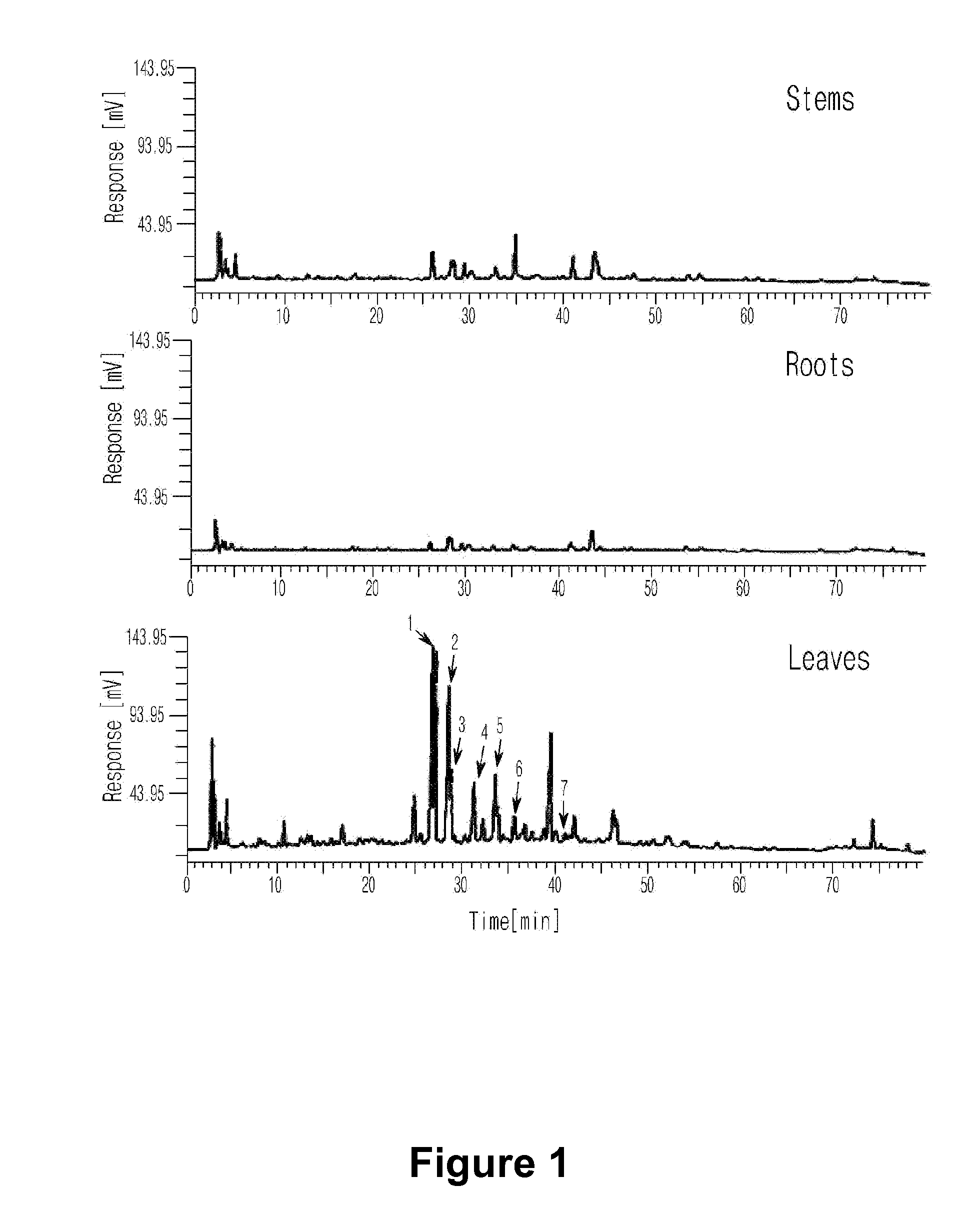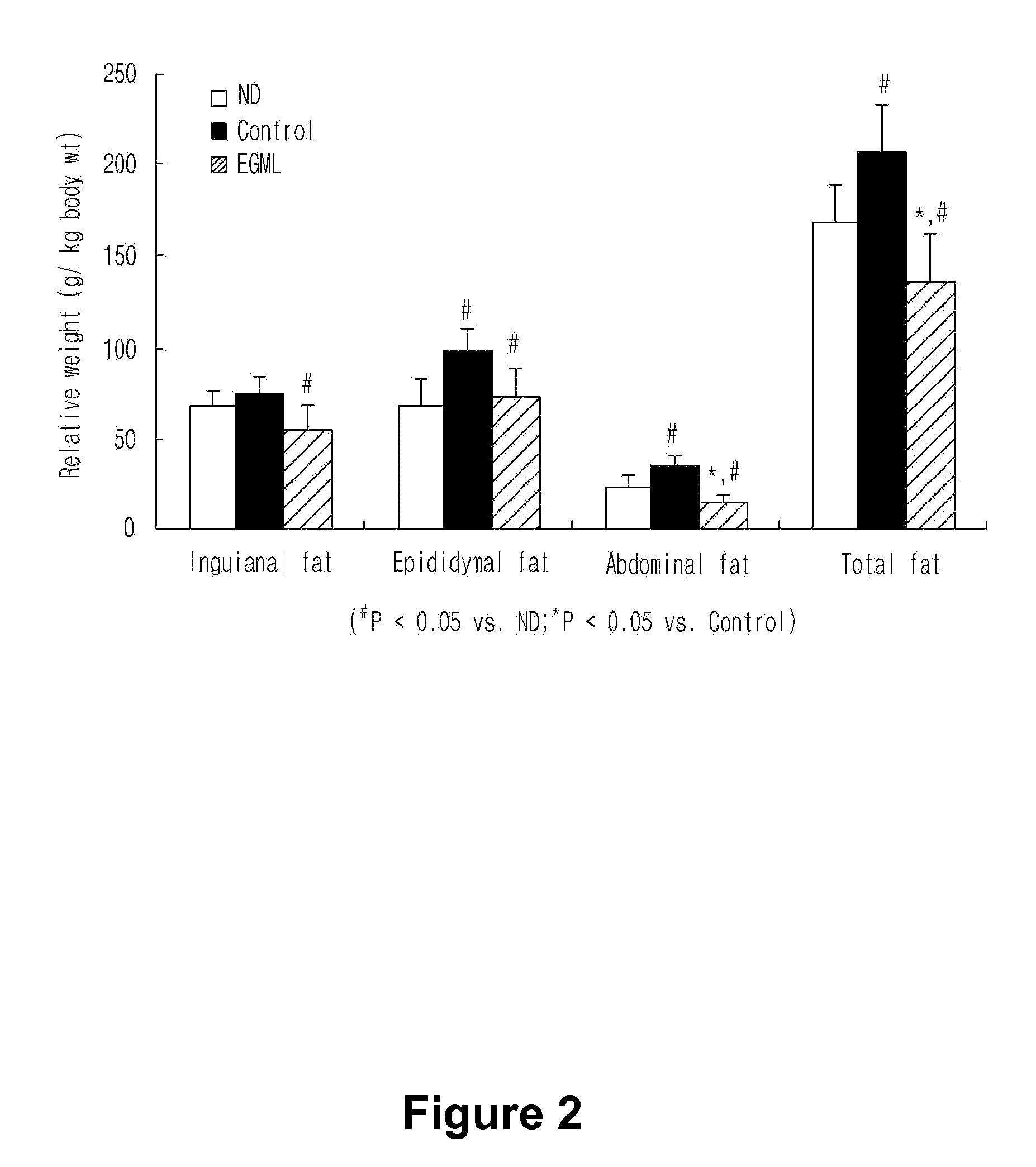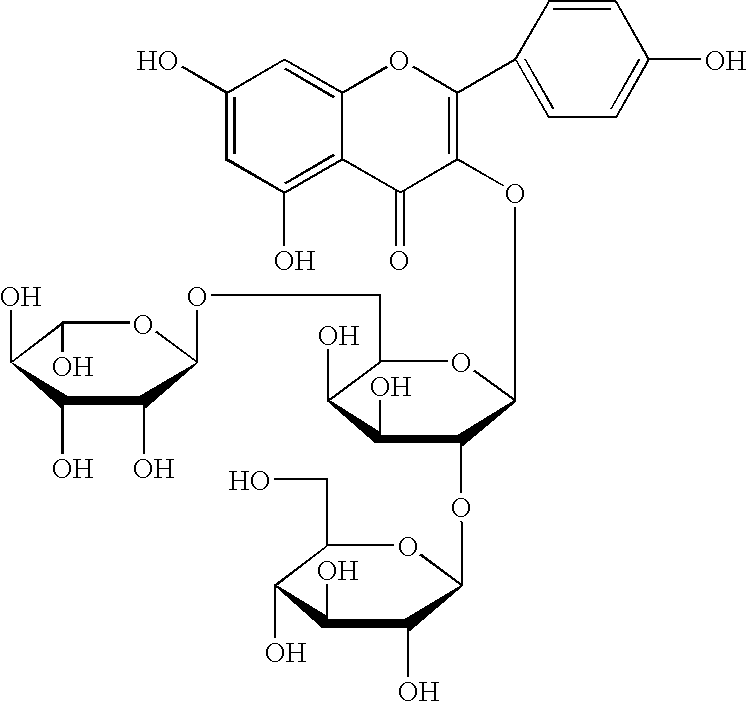Compositions for Preventing and Treating Obesity, Hyperlipidemia, Atherosclerosis, Fatty Liver, Diabetes or Metabolic Syndrome Containing Extracts of Glycine Max Leaves or Fractions Isolated from the Same as an Active Ingredient
a technology of glycine max leaves and extracts, which is applied in the direction of drug compositions, biocides, metabolic disorders, etc., can solve the problems of destroying the quality of life, affecting the treatment effect, and affecting the quality of life of patients, so as to inhibit the activity of cholesterol, inhibit the increase of high-fat diet-induced body fat, and the effect of effective us
- Summary
- Abstract
- Description
- Claims
- Application Information
AI Technical Summary
Benefits of technology
Problems solved by technology
Method used
Image
Examples
example 1
Preparation of Extracts of G. max Leaves
[0046] Ethanol Extracts of G. max Leaves
Soybeans were seeded in Jinju-si, Gyeongsangnam-do, Korea. After 90 days of growing, Soybean leaves (G. max leaves) were harvested and dried in the shade. The dried leaves were ground. 1 kg of the ground G. max leaves was extracted two times with 50 L of 95% ethanol for two days at room temperature. The extracts were filtered to recover ethanol-soluble part and combined. The combined ethanol extracts were concentrated under a reduced pressure, and the resulting ethanol extracts (181 g) of G. max leaves were obtained.
[0047] Hot Water Extracts of G. max Leaves
[0048]100 g of the ground G. max leaves were extracted with 1 L of water for 2 hours at 85-90° C. The extraction was repeated twice. The obtained extracts were filtered by filter paper to eliminate precipitates, and then filtrates were obtained. The filtrates were concentrated under a reduced pressure, and the resulting hot water extracts (15 g) of G....
example 2
Preparation from Fractions of Extracts of G. max Leaves
[0051]The ethanol extracts of G. max leaves (181 g) obtained in Example were suspended in 500 ml of water. Equal amount of hexane was added the aqueous suspension, followed by fractionation of water layer and hexane layer. The above procedure was repeated once again with water layer to fractionate hexane layer. After separating hexane layer, equal amount of ethyl acetate was added to water layer, followed by fractionation. The above ethyl acetate fractionation was repeated once again. The fractions were concentrated under a reduced pressure, and the resulting hexane fraction (18 g) and ethyl acetate fraction (32 g), respectively, were obtained.
experimental example 1
HPLC Analysis with Extracts of G. max Leaves
[0055]Following experiment was performed to compare / investigate ingredients of the extract of G. max leaves.
[0056]1 g of each soybean leaves (G. max leaves), roots and stems dried in the shade was put in a 50 ml-conical tube, and extracted with 20 ml of 80% methanol for 6 hours at room temperature. The extracts were filtered with filter paper (No. 6) and then filtered once again with 0.45 μm membrane filter. The extracts were separated and analyzed by HPLC (column: Spheri-5 RP-18, 5 mm, 250×4.6 mm; eluent: acetonitrile / water [40:60 (v / v)]; sample volume: 10 μl; elution speed: 1.0 ml / min; detection: UV 254 nm; HPLC machine: PE Series 200) and LC-Mass. The results were analyzed and compared with the previously reported data (Biomed. Pharmacother. 56: 289-295, 2002) and then presented in Table 2 and FIG. 1.
Table 2CompoundsStructureskaempferol-3-O-α-L- rhamnopyranosyl(1→2)-β-D- glucopyranosyl(1→6)-β-D- galactopyranoside (1)kaempferol-3-O-(2,6-...
PUM
 Login to View More
Login to View More Abstract
Description
Claims
Application Information
 Login to View More
Login to View More - R&D
- Intellectual Property
- Life Sciences
- Materials
- Tech Scout
- Unparalleled Data Quality
- Higher Quality Content
- 60% Fewer Hallucinations
Browse by: Latest US Patents, China's latest patents, Technical Efficacy Thesaurus, Application Domain, Technology Topic, Popular Technical Reports.
© 2025 PatSnap. All rights reserved.Legal|Privacy policy|Modern Slavery Act Transparency Statement|Sitemap|About US| Contact US: help@patsnap.com



